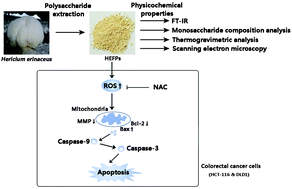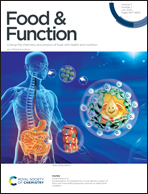Fruiting body polysaccharides of Hericium erinaceus induce apoptosis in human colorectal cancer cells via ROS generation mediating caspase-9-dependent signaling pathways
Abstract
The fruiting bodies of Hericium erinaceus (Bull.) Pers. are commonly used in China in the treatment of digestive system diseases. In this work, the polysaccharides from the fruiting bodies of Hericium erinaceus (HEFPs) were extracted, and their effects on human colorectal cancer cells (HCT-116 and DLD1) were investigated in vitro. Our results showed that HEFPs were mainly composed of arabinose, galactose, glucose, and mannose at a molar ratio of 8.99 : 11.15 : 1.2 : 1.97. They significantly inhibited the growth of these cells by inducing apoptosis by the modulation of Bax and Bcl-2 expression, which in turn induced the loss of mitochondrial membrane potential, leading to the activation of cleaved-caspase-9 and cleaved-caspase-3. These results suggested that HEFPs induced apoptosis via the caspase-9-depedent intrinsic mitochondrial pathway. Furthermore, HEFPs increased the level of reactive oxygen species (ROS) in HCT-116 and DLD1 cells. The addition of the antioxidant N-acetyl-L-cysteine reduced the ability of HEFPs to trigger the intrinsic mitochondrial pathway, indicating the role of ROS generation in the upstream pathway of HEFP-induced apoptosis. Therefore, the results described in this study could be of interest for further studies in finding functional foods or alternative therapeutic agents against colorectal cancer.



 Please wait while we load your content...
Please wait while we load your content...